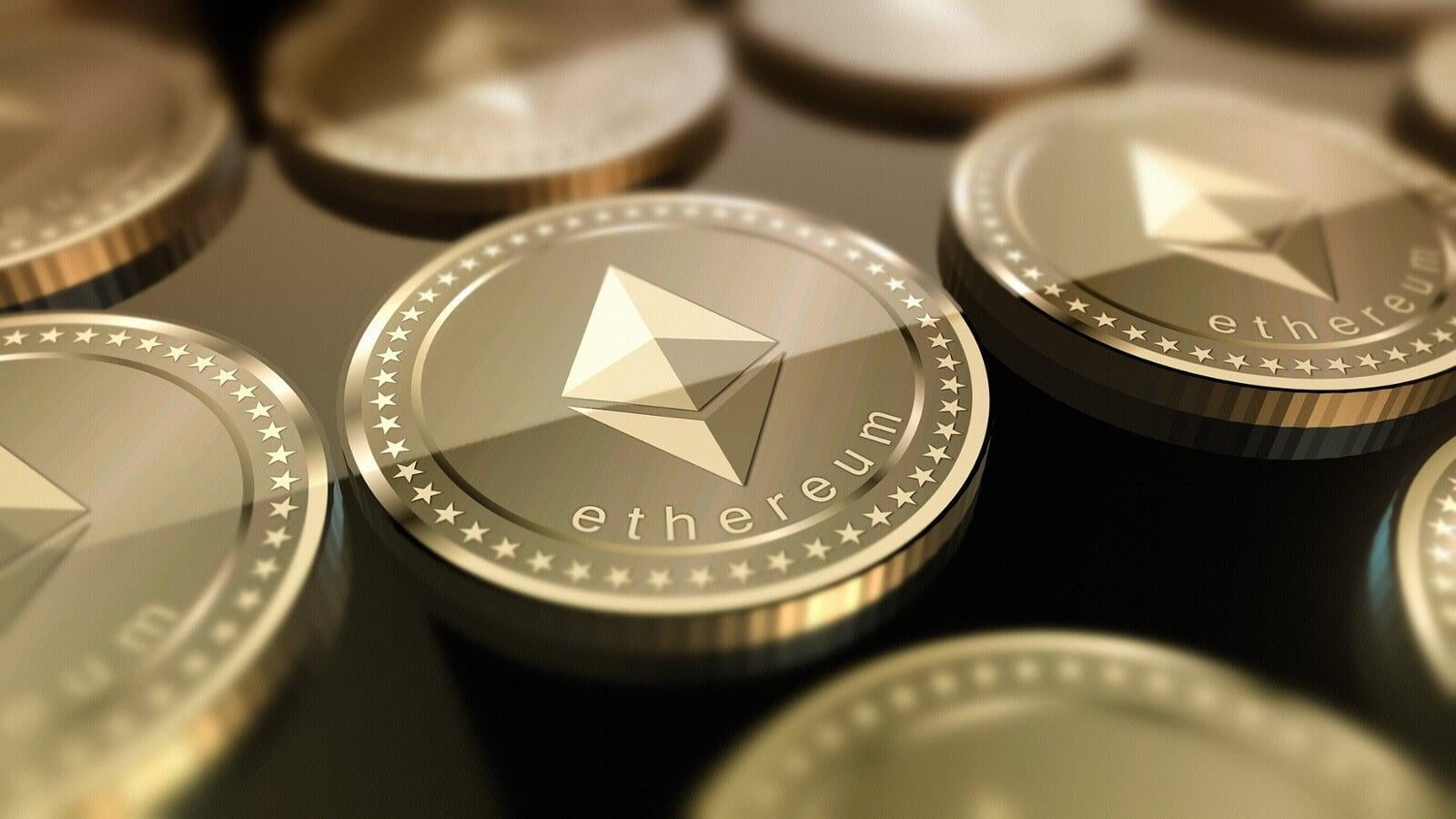
The last Escient Financial Insights post looked at Bitcoin. Now it's time to look at the second largest cryptocurrency by market cap, and the one that may have had the biggest impact on the financial system besides Bitcoin – Ethereum.
Ethereum. ether.
Similar to how there is a difference between Bitcoin and bitcoin, there is Ethereum and ether. Ethereum refers to the Ethereum network and ether refers to the cryptocurrency coin that runs on the network. The symbol for ether is ETH. Again, like Bitcoin, you will sometimes find Ethereum and ether used interchangeably.
Ethereum was initially described in a white paper by Vitalik Buterin in 2014 titled Ethereum: A Next-Generation Smart Contract and Decentralized Application Platform. That white paper laid the foundation for the Ethereum Virtual Machine, which is a platform powered by blockchain technology to support smart contracts and secure financial transactions. Whereas Bitcoin's main purpose is to provide a means for transferring a type of digital money from one user to another, Ethereum's main purpose is to provide a means for decentralized apps, or dApps, to run on top of it. The dApps that run on Ethereum use smart contracts to operate and allow users to transact.
An important characteristic to understand here is the layers of the blockchain. Each blockchain has a Layer 1, such as Bitcoin or Ethereum. On top of that layer is Layer 2, which allows other technologies to operate with the blockchain and take advantage of the network's power and abilities. With Bitcoin there aren't a lot of Layer 2 technologies running on top of it, but the Lightning Network is a significant one that speeds up transactions and lowers fees. Ethereum, on the other hand, has thousands of different technologies, tokens, and smart contracts running on it.
Smart Contracts
The foundation of an Ethereum transaction, whether it's on Layer 1 or Layer 2, is the smart contract. A smart contract is an agreement between two parties that automatically executes when certain criteria are met. I'll provide an example that I'm not aware of that can actually done yet, but I see it as a potential use case for smart contracts.
Say you have a used car you want to sell for $10,000. You find a buyer and establish a smart contract for the sale. The smart contract says that when the buyer sends 3.7 ether (approximately $10,000 today) to your Ethereum wallet address then the smart contract will automatically deliver the vehicle's title to the buyer, making the buyer the new legal owner of the car. It's completely automated and can happen almost instantly, removing the necessity of actually dealing with the DMV. Of course, in this hypothetical situation the DMV would need to begin using blockchain technology and smart contracts to allow these kinds of transactions and transfers of ownership. It is what the future could easily hold, saving a lot of time, money, and other resources for everyone involved. And that digital title? That would be an NFT (non-fungible token). More about those in a future Escient Financial Insights post.
That's basically how a smart contract works. Payment is sent and the other side automatically fulfills their obligation as dictated in the smart contract.
Decentralized Finance
Blockchain technology, and specifically Ethereum and other similar platforms, provide a foundation for decentralized finance, or DeFi. Where traditional centralized finance (CeFI) involves a central bank controlling transactions as an intermediary, DeFi removes the intermediary and allows two parties to transact directly with each other. There is no one to say you cannot withdraw or spend your funds and there is no one to delay receiving of funds from another party. This absence of an intermediary allows for many things, including much quicker transaction settlement speeds and potentially lower costs.
One thing new users will find interesting is the opportunities to acquire digital assets that you are unable to acquire from centralized exchanges, including NFTs and varying altcoins and tokens. Altcoins and tokens are a type digital asset that isn't a cryptocurrency, but are available through smart contracts. Some have utility within various dApps, such as providing voting power or an internal method of monetary exchange within an app like a game.
There are additional services available through DeFi as well, including the ability to make your digital assets available to be borrowed by someone else where they pay you interest that is typically much higher than interest rates available from traditional banks. There is also the ability to make your digital assets available for trading by others for rewards. This is called staking or yield-farming. These use a smart contract that states after a period of time or at your request you get your digital assets back. Disclaimer: there is a risk involved as it is possible for smart contract exploits to cause a loss of assets, so it's important to use reliable well-known DeFi apps and services and inspect the smart contracts first to reduce your risk.
The age of DeFi is in its infancy and presents possibilities and opportunities for financial growth, but is not without risks. It's crucial to do research and due diligence before embarking on any financial opportunity or investment.
Gas Fees
Just like with Bitcoin, each user pays a fee to send digital assets from one Ethereum wallet address to another. With Ethereum these are called gas fees and are calculated based on the network resources the transaction needs to be processed and verified. Currently, because of the number of transactions occurring on the Ethereum network, and the complexity of those transactions, gas fees tend to be quite high right now. However, there is a significant upgrade coming to Ethereum later this year that is expected to increase the capabilities of the network to process more transactions at a faster rate and lower transaction fees.
Proof-of-Work vs. Proof-of-Stake
Bitcoin transactions are processed through a process where miners compete for the right to process a new block of transactions. This is called Proof-of-Work (or PoW) consensus. Ethereum currently uses essentially the same process, but is in the process of migrating from Proof-of-Work to Proof-of-Stake (or PoS) consensus. With Proof-of-Stake, the right to process a new block of transactions is randomly awarded to miners who hold a minimum amount of the the native cryptocurrency (in Ethereum's case it would be ether). One of the benefits of this is a significant reduction in the amount of computing power that's necessary for mining because miners are no longer incentivized for being the first to solve an equation since they are chosen randomly.
Proof-of-Stake consensus systems also make it easier for normal users (i.e. non-miners) to stake their cryptocurrency and earn rewards or interest by allowing a miner to use their cryptocurrency for staking pool and share rewards and transactions fees with those who do.
Inflation vs. Deflation
Whereas Bitcoin has a maximum limit of 21 million bitcoin that will ever be created, Ethereum's ether does not have such a limit. There are currently 118 million ether in circulation, and that number will continue to grow. However, Ethereum's transition to Proof-of-Stake changes how new ether is mined and how transaction fees are assessed. The new method will actually burn some of the ether that is paid as transaction fees for each transaction. Burn is a term used in cryptocurrency to describe the process of taking coins out of circulation. It typically involves sending the coins to a non-existent wallet address or a wallet address that is not accessible by anyone. It is akin to burning US dollars, hence the word burn. Burning coins limits the amount of new ether entering circulation as each block is added to the blockchain, resulting in a slow-down of inflation and potentially result in deflation of the value.
Tokens
More than just ether can be sent from and received to an Ethereum account. Many of the apps that run on Ethereum have their own cryptocurrencies, called tokens. Tokens can have various purposes and uses. They can allow for voting power within the app or protocol it represents. They can also be a medium of monetary exchange within an app. For example, if Minecraft ran on a blockchain, rather than purchase Minecraft coins within Minecraft to purchase items within the game, a user would purchase Minecraft tokens. The value of those tokens could change over time, a person could sell their Minecraft tokens to anyone they wanted, or a user could create their own upgrades for the game and sell them for Minecraft tokens.
What are the Advantages of Ethereum?
It is possible to send and receive ether anywhere in the world at any time. No bank holidays. No borders. No bureaucracy. Ethereum allows its users to be in full control of their money. Because it's decentralized there is no authority that can take your money from you.
Payment Freedom
It is possible to send and receive ether anywhere in the world at any time. No bank holidays. No borders. No bureaucracy. Ethereum allows its users to be in full control of their money. Because it's decentralized there is no authority that can take your money from you.
Transaction Settlement Time
When you pay with a credit card, you might receive authorization right away, but it could take a few days for the transaction to actually be on your credit card account. For merchants, it's the same delay, if not longer, before they can have access to those funds. For checks, it could be even longer. Depending on the amount it could take a week. For an ACH transfer it could take a few days, but some merchants require up to 10 business days. Wire transfers could take a few days as well, even with high fees, especially for international transfers. With Ethereum, transaction settlement times could take as little as a few seconds. Most do take longer, from a couple minutes to a few hours,, depending the network load and the gas fees you're paying, but the speed at which Ethereum transactions are able to verify and settle is significantly faster and less expensive than with the traditional banking system.
Choose Your Own Fees
There is no fee to receive ether, and many wallets let you control how large a fee to pay when spending. Higher fees can encourage faster confirmation of your transactions. Additionally, merchant processors exist to assist merchants in processing transactions, converting ether to fiat currency and depositing funds directly into merchants' bank accounts daily. As these services are based on Ethereum, they can be offered for much lower fees than with other payment services.
Fewer Risks for Merchants
Ethereum transactions are secure, irreversible, and do not contain customers’ sensitive or personal information. This protects merchants from losses caused by fraud or fraudulent chargebacks. Merchants can easily expand to new markets where either credit cards are not available or fraud rates are unacceptably high. The net results are lower fees, larger markets, and fewer administrative costs.
Security and Control
Ethereum users are in full control of their transactions; it is impossible for merchants to force unwanted or unnoticed charges as can happen with other payment methods. Ethereum payments can be made without personal information tied to the transaction. This offers strong protection against identity theft. Ethereum users can also protect their money with backup and encryption. Further, an Ethereum wallet cannot be brute-force hacked, or at least none have been hacked yet. For more details on this, read the previous Escient Financial Insights post About Those Objections to Cryptocurrency You May Have Heard….
Transparent and Neutral
All information concerning the Ethereum network and the ether money supply itself is readily available on the blockchain for anybody to verify and use in real-time. No individual or organization can control or manipulate the Ethereum protocol because it is cryptographically secure. This allows the core of Ethereum to be trusted for being completely neutral, transparent, and predictable.
No Centralized Censorship
Ethereum lacks a central authority that could censor users. For example, because apps can run on top of Ethereum, it's possible for a social media platform like Twitter to run on the Ethereum blockchain. Without a central authority, the only way for a user to be censored (i.e. a tweet removed or a user banned) would be if a majority of the rest of the community voted to do so.
Smart Contracts
Smart contracts automate many of the steps taken by central authorities on the traditional web. For example, if a freelancer uses a website to find clients and set up payment contracts, then that website takes a percentage of the contract or charges a flat fee to be an intermediary. With smart contracts on Web 3.0 (the name for the web that can run on a blockchain and other newer technologies), a client can write a smart contract that simply states, "if the project is completed by X date, the funds will be released." The rules are hard-coded into the contract, and the funds are set aside so they will be available when the project is completed by that date. The fees can also be lower with smart contacts.
What are the Disadvantages of Ethereum?
Everything that has advantages also has disadvantages, and it's important to be aware of them so you can weigh the pros and cons for yourself. Here are some of the most prominent disadvantages for Ethereum.
Acceptance
Many people are still unaware of Ethereum or are not using it yet. More businesses are beginning to accept Ethereum and other cryptocurrencies because they want the advantages of doing so, but the list remains small and still needs to grow in order to benefit from network effects.
Volatility
The total value of ether in circulation and the number of businesses using Ethereum are still very small compared to what they could be. Therefore, relatively small events, trades, or business activities can significantly affect the price. In theory, this volatility will decrease as Ethereum markets and the technology matures. This is a new asset class and a for of currency at the same time, so it's difficult to imagine and know how it will play out.
Ongoing Development
Ethereum software is still in active development, and may always be. New tools, features, and services are being developed to make Ethereum more secure and accessible to the masses. Some of these are still not ready for everyone. Most exchanges and markets for ether are new and lack full regulation, and may offer no insurance. In general, Ethereum is still in the process of maturing.
Not Completely Anonymous
Ethereum is designed to allow its users to send and receive payments with an acceptable level of privacy as well as any other form of money. However, Ethereum is not anonymous and cannot offer the same level of privacy as cash. The use of Ethereum leaves extensive public records. Various mechanisms exist to protect users' privacy, but it is possible to track transactions and accounts. This is a disadvantage for some, but could also be seen as an advantage as it does help make Ethereum less enticing to bad actors who would use it for fraud or criminal activity.
Some concerns have been raised that private transactions could be used for illegal purposes. However, it is worth noting that Ethereum will undoubtedly be subjected to similar regulations that are already in place inside existing financial systems. Ethereum cannot be more anonymous than cash and it is not likely to prevent criminal investigations from being conducted. Additionally, Ethereum is also designed to prevent a large range of financial crimes.
Scalability and Fees
When Ethereum was first envisioned it was difficult to predict its success and the growing user base that exists now. Thus, over the last couple years the Ethereum network has exhibited issues with its ability to handle large numbers of transactions, which has resulted in very high gas fees. Although it is currently in process of the significant upgrades, the advantages of those upgrades are not yet available for the general public to take advantage of. Longer transaction times and high gas fees continue to push users toward other protocols and blockchains, and more time for competitors to enter the market and take some of Ethereum's marketshare.
Ethereum vs. Bitcoin
Ethereum is often compared to Bitcoin. Although the two cryptocurrencies have similarities, there are some distinct differences. Whereas the Bitcoin blockchain was created to only support the bitcoin cryptocurrency with the purpose as a method of monetary exchange, the Ethereum blockchain was created as a programmable network that can run applications and support a number of different cryptocurrency coins and tokens that serve various purposes. Both serve different purposes and different utility, so there is not really any kind of one is better than the other comparison or any purpose of choosing one over the other.
How to Purchase and Use Ethereum
There are two main common ways to acquire ether.
Centralized Exchange
The easiest way to purchase ether is to open an account at a centralized exchange such as Gemini, Coinbase, Binance.us, Crypto.com, or others. There you can transfer fiat money such as US dollars from your bank account to your exchange account and then purchase ether. In most cases you can transfer via ACH and buy ether instantly.
To send ether from a centralized exchange to your own Ethereum wallet or to someone else you'll need the Ethereum address to send it to. To get the public Ethereum address, whoever you want to send the ether to selects the receive option in their wallet, which presents a public address and QR code. The address is a long string of alphanumeric characters starting with "0x". Simply copy the address or scan the QR code and send the ether.
Note that it's imperative that the address you enter is 100% accurate. Even one wrong character will result in sending the ether or token to the wrong address or to an address that doesn't exist and there is no way of retrieving the ether or token if that happens.
When you send ether from an exchange to an Ethereum address most exchanges will present you with a confirmation screen where you can verify the recipient's address, the amount of ether, and the fee to send the ether. You may also have to confirm the transaction using a form of two-factor authentication (2FA). Every exchange is different, with different features, rules, and fees, so it's a good idea to compare them.
A Cryptocurrency Wallet
Another way is to have someone send you ether to your own Ethereum wallet. To do this you need to create a wallet. There are different kinds of wallets and many of each kind are available. That topic will be covered in a future Escient Financial Insights post. Once you have your own cryptocurrency wallet you can select the option to receive ether and then essentially follow the same steps as above.
Sending ether from your own wallet works pretty much the same way, except that there is usually a confirmation screen where you confirm the recipient's address, the amount of ether being sent, and the gas fee. Most wallets allow you to customize the gas fee, so you could pay a lower gas fee, but have a longer transaction time, or you can pay a higher gas fee to settle the transaction quicker. Some wallets will require approving the transaction using private keys on a separate device. This is a security feature of some wallets to protect your wallet from becoming subject to malware or hacking of your computer or mobile device. Again, more on this later in a future Escient Financial Insights post.
The key here is that it's actually pretty easy to transfer ether from one person to another. It's almost as simple as if you were typing in someone's email address or phone number to pay with Apple Pay, PayPal, Venmo, or other similar payment services. The key difference is that the account address is much longer and you have to be extra careful to make sure the address you're sending to is the right one. Also, the transaction will most likely settle in a matter of minutes so the recipient won't have to wait to be able to use the money that was sent to them.
Should You Purchase or Invest in Ethereum?
There is potential for Ethereum to increase in value. However, Ethereum does have a high amount of volatility and does have risk. Each individual should research Ethereum on their own and weigh the pros and cons when deciding whether or not to purchase ether or invest in some. Escient Financial does offer advice on digital assets and cryptocurrency, so if you would like assistance in making the decision, feel free to...
This content is developed from sources believed to be providing accurate information. The information in this material is not intended as investment, tax, or legal advice. It may not be used for the purpose of avoiding any federal tax penalties. Please consult legal or tax professionals for specific information regarding your individual situation. The opinions expressed and material provided are for general information, and should not be considered a solicitation for the purchase or sale of any security. Digital assets and cryptocurrencies are highly volatile and could present an increased risk to an investors portfolio. The future of digital assets and cryptocurrencies is uncertain and highly speculative and should be considered only by investors willing and able to take on the risk and potentially endure substantial loss. Nothing in this content is to be considered advice to purchase or invest in digital assets or cryptocurrencies.
Enjoying Escient Financial’s Insights?
The weekly newsletter is usually delivered to your email inbox Friday or Saturday, and includes:
- the latest Escient Financial Insights articles
- a brief of the week's important news regarding the markets
- recommended third-party reads
- selected Picture of the Week
Escient Financial does NOT sell subscriber information. Your name, email address, and phone number will be kept private.
















